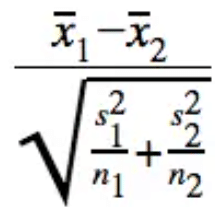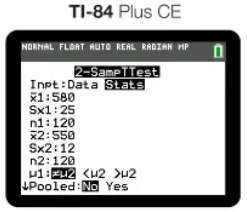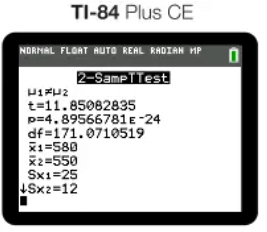Carrying Out a Test for the Difference of Two Population Means Chapter Notes | AP Statistics - Grade 9 PDF Download
Overview of the Two-Sample T-Test
Once you've confirmed that the assumptions for a two-sample t-test are satisfied, you can proceed to evaluate whether the difference between two population means is statistically significant. This involves computing the test statistic and determining the p-value, which helps assess whether the observed difference between sample means is likely due to chance.
Steps for Conducting the Test
Calculating the Test Statistic
To compute the test statistic for a two-sample t-test, follow these steps:
- Find the difference between the two sample means (mean1 - mean2).
- Calculate the standard error of the difference, which accounts for the standard deviations and sample sizes of both groups.
- Divide the difference by the standard error to obtain the t-score.
The formula for the t-score, specific to comparing two population means, is simplified as:
t = (mean1 - mean2) / sqrt((s1²/n1) + (s2²/n2))
This formula is available on the AP Statistics Formula Sheet, adjusted for the two-sample case.
Determining Degrees of Freedom
Degrees of freedom (df) are essential for interpreting the t-score:
- Manual Calculation: Take the smaller of the two sample sizes and subtract 1 (similar to single-sample t-tests in Unit 7.5).
- Using Technology: When using a graphing calculator or statistical software, the degrees of freedom are provided in the output.
Critical Value (t-score)
To calculate our critical value, we used the typical formula:
 To make it more specific for a t-score with the difference of two population means, our formula simplifies to:
To make it more specific for a t-score with the difference of two population means, our formula simplifies to:
Finding the P-Value
The p-value indicates the probability that the observed difference between sample means occurred by random chance. To find it:
- Manual Approach: Use a t-table with the calculated degrees of freedom. Locate the row for your df and find the t-score closest to your calculated value. The corresponding tail probability is an approximate p-value.
- Technology Approach: Perform a two-sample t-test using a graphing calculator or software. Input either the summary statistics (means, standard deviations, sample sizes) or raw data in lists. The output will include the t-score, degrees of freedom, and p-value.
 And our output would be as follows:
And our output would be as follows:
AP Exam Tip: Always report the t-score, degrees of freedom, and p-value in your response to earn full credit.
Testing the Statistical Claim
Compare the p-value to the significance level (typically α = 0.05):
- If the p-value is less than the significance level, reject the null hypothesis. This suggests strong evidence supporting the alternative hypothesis.
- If the p-value is greater than or equal to the significance level, fail to reject the null hypothesis, indicating insufficient evidence to support a difference.
Example: Green Bean Fields
Consider a scenario from Unit 7.8 where we compare the mean number of green beans picked from two fields (Field A and Field B). After performing a two-sample t-test, suppose the output is:
- t-score: [calculated value]
- Degrees of freedom: [calculated df]
- P-value: ~0.000
Conclusion: Since the p-value (~0.000) is less than 0.05, we reject the null hypothesis. There is convincing evidence that the true mean number of green beans picked from Field A differs from that of Field B. This conclusion is contextualized to the problem, compares the p-value to the significance level, and clearly states the decision regarding the null and alternative hypotheses.
Key Terms to Understand
- Alternate Hypothesis: A statement proposing a difference, effect, or relationship in a statistical test, contrasting the null hypothesis. It guides the test by suggesting there is an effect worth investigating.
- Degrees of Freedom: The number of independent values that can vary in a statistical calculation without violating constraints. It affects the distribution of the test statistic and is critical for hypothesis tests and confidence intervals.
- Null Hypothesis: A baseline assumption that there is no effect or difference in the population, used as a starting point for statistical testing.
- Significance Level (α): The threshold (e.g., 0.05) for deciding whether to reject the null hypothesis, representing the probability of a Type I error (false positive).
- Standard Error: A measure of how accurately a sample mean represents the population mean, quantifying variability. It is used in hypothesis tests and confidence intervals to assess precision.
- Statistical Significance: The likelihood that an observed result is not due to chance, determined by comparing the p-value to the significance level. A significant result supports rejecting the null hypothesis.
- Type I Error: Incorrectly rejecting a true null hypothesis, also known as a false positive, indicating a nonexistent effect or difference.
- Type II Error: Failing to reject a false null hypothesis, missing a true effect or difference in the population.
- Two-Sample T-Test: A statistical test to compare the means of two independent groups, assuming normal distribution and similar variances in the populations.
|
12 videos|106 docs|12 tests
|
FAQs on Carrying Out a Test for the Difference of Two Population Means Chapter Notes - AP Statistics - Grade 9
| 1. What is a Two-Sample T-Test ? |  |
| 2. When should I use a Two-Sample T-Test ? |  |
| 3. What are the assumptions of the Two-Sample T-Test ? |  |
| 4. How do I interpret the results of a Two-Sample T-Test ? |  |
| 5. What is the difference between a Two-Sample T-Test and a Paired T-Test ? |  |















